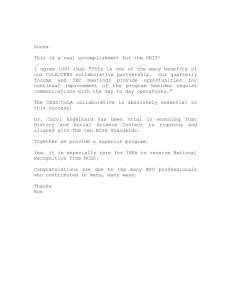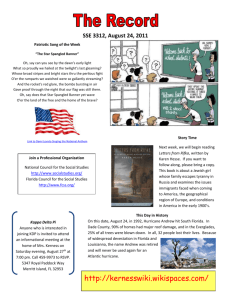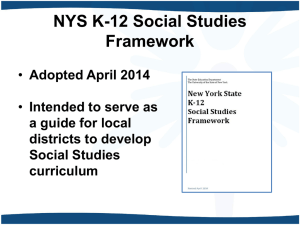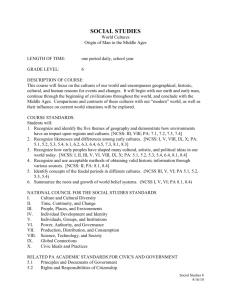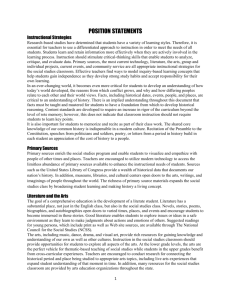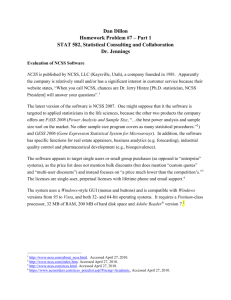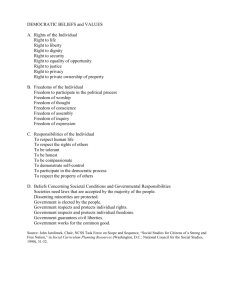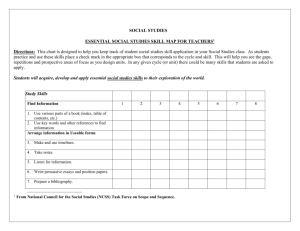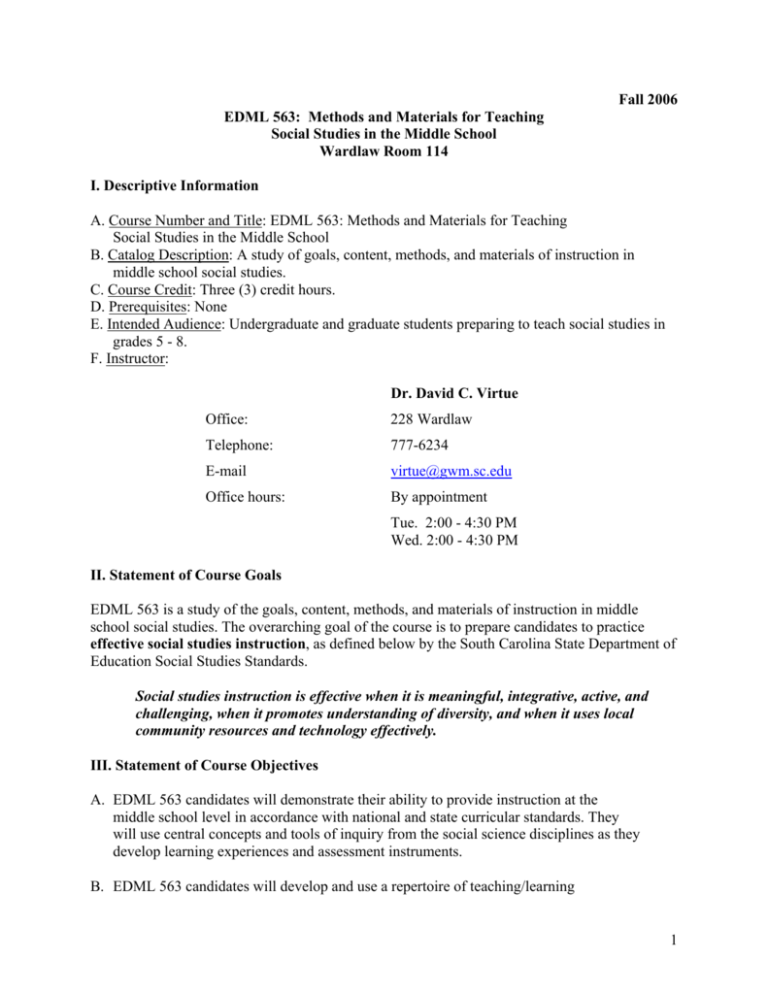
Fall 2006
EDML 563: Methods and Materials for Teaching
Social Studies in the Middle School
Wardlaw Room 114
I. Descriptive Information
A. Course Number and Title: EDML 563: Methods and Materials for Teaching
Social Studies in the Middle School
B. Catalog Description: A study of goals, content, methods, and materials of instruction in
middle school social studies.
C. Course Credit: Three (3) credit hours.
D. Prerequisites: None
E. Intended Audience: Undergraduate and graduate students preparing to teach social studies in
grades 5 - 8.
F. Instructor:
Dr. David C. Virtue
Office:
228 Wardlaw
Telephone:
777-6234
E-mail
virtue@gwm.sc.edu
Office hours:
By appointment
Tue. 2:00 - 4:30 PM
Wed. 2:00 - 4:30 PM
II. Statement of Course Goals
EDML 563 is a study of the goals, content, methods, and materials of instruction in middle
school social studies. The overarching goal of the course is to prepare candidates to practice
effective social studies instruction, as defined below by the South Carolina State Department of
Education Social Studies Standards.
Social studies instruction is effective when it is meaningful, integrative, active, and
challenging, when it promotes understanding of diversity, and when it uses local
community resources and technology effectively.
III. Statement of Course Objectives
A. EDML 563 candidates will demonstrate their ability to provide instruction at the
middle school level in accordance with national and state curricular standards. They
will use central concepts and tools of inquiry from the social science disciplines as they
develop learning experiences and assessment instruments.
B. EDML 563 candidates will develop and use a repertoire of teaching/learning
1
strategies that are appropriate for young adolescent learners.
Lessons should be developed and used in which middle school students:
- gather data from a variety of sources
- categorize or classify
- interpret and analyze for example primary resources
- establish cause/effect relationships
- determine the validity of information and arguments
- evaluate and present information in well reasoned ways that support better decisionmaking for both individuals and society
Students should be able to develop
- diagrams, charts, and tables
- graphs, timelines, pictures, and maps
- a story, narrative, or essay that shows patterns or synthesizes information they have
learned.
C. EDML 563 candidates will make connections between practice and theory as they
reflect on the effectiveness of selected lessons that they and others have taught.
IV. Required Textbooks and Articles
National Council for the Social Studies. (1994). Expectations of excellence:
Curriculum standards for social studies. Bulletin 89. Washington, DC: NCSS
http://www/socialstudies.org/standards
Tennenbaum, I. M. (2000) South Carolina Social Studies Curriculum Standards.
Columbia, SC: South Carolina Department of Education.
http://www.myscschools.com/offices/cso/Social_Studies/socials.htm
http://www.sde.state.sc.us/offices/cso/social_studies/social.htm
Other resources will be distributed in class or posted on Blackboard. EDML 563 teacher
candidates will also be required to view video clips, lesson plans and articles from specific
websites. These websites may include:
ERIC Clearinghouse for Social Studies/Social Science Education
http://www.indiana.edu/~ssdc/eric_chess.htm
South Carolina Council for the Social Studies
http://www.sccss.org
Discovery Channel School Lesson Plans
http://school.discovery.com/lessonplans/
The Educator’s Reference Desk
http://www.eduref.org/
Social Studies Update
http://www.sde.state.sc.us/offices/cso/Social_Studies/ss_updates.htm
2
V. Course Requirements
A. Journal (Blackboard) (Weight: 20%)
Participants will respond to prompts posted by the instructor AND to the postings of other
participants on the Blackboard discussion board.
EDTE 563 Blackboard Discussion Scoring Guide
Criterion:
On-time
Thorough
Thoughtful
Well-written
Excellent
Responses were on time (2)
Responses addressed all aspects of prompts (4)
Validated, responded thoughtfully to or elaborated upon another post (2)
Responses contained fewer than three errors in grammar, spelling, or
usage (2)
Total: 10
B. Videotape lesson case study (Weight: 20%) – Due 12/4
C. Mini Lessons and Reflections (Weight: 20%) – Due 10/9, 11/20
D. Class assignments/attendance/reading quizzes (Weight: 20%)
E. Final (Weight: 20%) – Due 12/11
Note: The final exam for graduate students will be different from the final exam for
undergraduates.
PLEASE NOTE: University policies regarding academic responsibility WILL BE STRICTLY
ENFORCED! If you have ANY questions about the applicability of these policies to your work
PLEASE ASK ME. See: Student Affairs Policy STAF 6.25
http://www.sa.sc.edu/carolinacommunity/judicial.htm#Academic%20Responsibility
VI. Course Evaluation
Final grades will be assigned based on the following scale:
A 93-100%
B+ 89-92%
B 83-89%
C+ 79-82%
C 73-79%
D+ 69-72%
D 65-68%
F >65%
Five points will be subtracted for each absence after more than one absence from class.
Attendance and participation are very important in this course!
3
VII. Tentative Course Outline
The following is a list of topics and readings for the semester. Class will meet on Mondays and
Wednesdays from 8:00 – 9:15 except on days that we “block.” Block class sessions will meet
from 8:00 – 10:45. Check Blackboard daily for changes to the schedule and announcements.
Date
Aug. 28
Aug. 30
Topic(s)
Course Overview
Defining the Field
Social Studies Curriculum
Sep. 6
Approaches to Social Studies
Sep. 11
What “Good” Looks Like (And Why)
Sep. 13
Motivation and Management
Sep. 18
Planning Instruction and Assessment I
Sep. 20
Sep. 25
(Block)
Oct. 2
Oct. 4
Planning Instruction & Assessment II
Mini Lessons
Mini Lessons
Reading & Writing in Social Studies
Oct. 9
Using Literature in Social Studies
Oct. 11
Web Quests & Current Events
Oct. 16
Issues-Centered Social Studies
Oct. 18
Oct. 25
(Block)
Oct. 30
(Block)
Music & Media in Social Studies
Practice Observations/Field Trip
Readings
Course syllabus
Handouts
Parker (2005)
Tennenbaum (2005)
Foster & Field (2004)
White, O’Brien, Smith, Mortensen,
Hileman (2006)
Duplass & Ziedler (2002)
Gibson & McKay (2001)
Hoge & Foster (2004)
Roach (2004)
Metzger (2000)
Van Sickle (1996)
Garrison (2006)
UBD & Backward Design web sites
Learning plan template
Sandmann & Ahern (2002)
McCoy (2003)
Ricklin (2006)
Vardell (2003)
Kennedy (2004)
Milson (2001)
Rose (2002)
Van Fossen (2004)
Engle (1996)
Gross (1996)
Harris (1996)
Passe & Evans (1996)
Totten & Pedersen (1996)
Holliday & Grskovic (2002)
Frank (1999) handout
Miner (1956) handout
Mini Lessons
4
Date
Nov. 8
(Block)
Nov. 15
(Block)
Nov. 20
Topic(s)
Mini Lessons
Readings
Rounds/Observations – Site TBA
Rounds Debriefing
Nov. 27
(Block)
Dec. 4
Presentations of Video Reflections
Dec. 11
Final Essay Due
Service Learning & Social Studies
Field, Wilhelm, Nickell, Culligan,
& Sparks (2001)
Hernandez & Metzger (1996)
Taylor & Larson (2000)
Harwood & Chang (1999)
Wade (2000)
BIBLIOGRAPHY
Allen, M.G., & Stevens, R.L. (1994). Middle Grades Social Studies. Boston: Allyn &
Bacon.
An abolitionist cartoon, 1830. (2005). Middle Level Learning, 24, M16.
Barber, B. R. (2000). Challenges to the common good in the age of globalism. Social Education,
64(1), 8-13.
Brown, C.S. (1994). Connecting with the Past. Portsmouth, NH: Heinemann.
Crook, J.B. (1994). The social studies teacher as curriculum creator: Reflections on
teaching middle school social studies. In E. W. Ross (ed.), Reflective Practice in
Social Studies. NCSS Bulletin No. 88 (pp. 13-22). Silver Spring, MD: NCSS.
Duplass, J. A., & Ziedler, D. L. (2002). Critical thinking and logical argument. Middle Level
Learning, 15, M10-M13.
Engle, S. H. (1996). Forward. In R. W. Evans & D. W. Saxe (Eds.), Handbook on teaching
social issues: NCSS bulletin 93 (pp. v-viii). Washington, DC: National Council for the
Social Studies.
Field, S. L., Wilhelm, R., Nickell, P., Culligan, J., & Sparks, J. (2001). Teaching middle school
social studies: Who is at risk? Social Education, 65(4), 225-230.
Foster, S. J., & Field, S. L. (2004). An introduction to contextual teaching and learning methods.
In J. D. Hoge, S. L. Field, S. J. Foster & P. Nickell (Eds.), Real-world investigations for
social studies: Inquiries for middle and high school students based on the ten NCSS
standards (pp. 1-5). Upper Saddle River, NJ: Pearson.
5
Furin, T. L. (2003). High-stakes testing: Death of our democracy? Social Studies and the Young
Learner, 15(4), 32.
Garrison, C. (2006). More than paper load: What does all this student work tell us? Middle
Ground, 9(3), 12-15.
Gibson, S., & McKay, R. What Constructivist Theory And Brain Research May Offer
Social Studies. [Online] Available
http://www.quasar.ualberta.ca/css/Css_35_4/ARconstructionist_theory.htm
Gross, R. E. (1996). World history and issues-centered instruction. In R. W. Evans & D. W. Saxe
(Eds.), Handbook on teaching social issues: NCSS bulletin 93 (pp. 161-163).
Washington, DC: National Council for the Social Studies.
Harris, D. (1996). Assessing discussion of public issues: A scoring guide. In R. W. Evans & D.
W. Saxe (Eds.), Handbook on teaching social issues: NCSS bulletin 93 (pp. 289-297).
Washington, DC: National Council for the Social Studies.
Harwood, A. M., & Chang, J. (1999). Inquiry-based service-learning and the Internet. Social
Studies and the Young Learner, 12(1), 15-18.
Hernandez, H., & Metzger, D. (1996). Issues-centered education for language-minority students.
In R. W. Evans & D. W. Saxe (Eds.), Handbook on teaching social issues: NCSS bulletin
93 (pp. 111-120). Washington, DC: National Council for the Social Studies.
Hoge, J. D., Field, S.L., Foster, S.J. & Nickell, P. (2004). Real-world investigations
for social studies. Columbus, OH: Pearson/Prentice Hall.
Hoge, J.D. (1996). Effective Elementary Social Studies. Cincinnati, OH: Wadsworth.
Hoge, J. D., & Foster, S. J. (2004). Mandatory school uniforms: A real-world exploration of
power, authority, and governance. In J. D. Hoge, S. L. Field, S. J. Foster & P. Nickell
(Eds.), Real-world investigations for social studies: Inquiries for middle and high school
students based on the ten NCSS standards (pp. 121-148). Upper Saddle River, NJ:
Pearson.
Holliday, D. C., & Grskovic, J. A. (2002). Using political cartoons: An activity for students of
every ability. Middle Level Learning, 15, M8-M9.
Howard, J. (2001). Graphic Representations as Tools for Decision Making. Social Education,
65(4), 220-223.
Kennedy, S. (2004). The well-constructed webquest. Social Studies and the Young Learner,
16(4), 17-19.
Massialas, B.G., & Allen, R.F. (1996). Crucial Issues in Teaching Social Studies K-12.
6
Cincinnati, OH: Wadsworth.
McCoy, M. M. (2003). Incorporating effective writing strategies. Social Education, 67(4), 200202.
Metzger, D. (2000). Young citizens: Partners in classroom management. Social Studies and the
Young Learner, 12(4), 21-23.
Milson, A. J. (2001). Exploring Latin America with webquests. Social Studies and the Young
Learner, 14(2), P1.
National Council for the Social Studies. (1994). Expectations of excellence:
Curriculum standards for social studies. Bulletin 89. Washington, DC: NCSS
http://www/socialstudies.org/standards
O'Brien, J. E., & White, S. H. (2006). Recapturing the history standards: History inquiry in the
middle grades. Middle School Journal, 17(4), 11-16.
O'Mahony, C. (2003). Helping students understand their own global connections. Social Studies
and the Young Learner, 15(4), 9-10.
Parker, W. C. (2005). Social studies education: What and why. In Social studies in elementary
education (pp. 2-27). Upper Saddle River, NJ: Pearson.
Passe, J., & Evans, R. W. (1996). Discussion methods in an issues-centered curriculum. In R. W.
Evans & D. W. Saxe (Eds.), Handbook on teaching social issues: NCSS bulletin 93 (pp.
81-88). Washington, DC: National Council for the Social Studies.
Ricklin, L. P. (2006). Poems for two voices: An interdisciplinary activity. Middle Level
Learning, 25, M14-M15.
Roach, P. S. (2004). Defusing hate: With malice toward none, with charity for all. In J. D. Hoge,
S. L. Field, S. J. Foster & P. Nickell (Eds.), Real-world investigations for social studies:
Inquiries for middle and high school students based on the ten NCSS standards (pp. 87120). Upper Saddle River, NJ: Pearson.
Rose, S. (2002). Using currents events media in the classroom. Social Studies and the Young
Learner, 14(3), P1-P2.
Sandmann, A. L., & Ahern, J. F. (2002). Part one: Using literature to teach social studies. In
Linking literature with life: NCSS bulletin 99 (pp. 9-29). Silver Springs, MD: National
Council for the Social Studies.
Shaver, J. P. (1996). Afterword. In R. W. Evans & D. W. Saxe (Eds.), Handbook on teaching
social issues: NCSS bulletin 93 (pp. 380-386). Washington, DC: National Council for the
Social Studies.
7
Taylor, D. B., & Wood, K. D. (2005). Activating study skills in the middle school classroom.
Middle School Journal, 36(5), 51-55.
Taylor, H. E., & Larson, S. M. (2000). Teaching elementary social studies to students with mild
disabilities. Social Education, 64(4), 232-235.
Tennenbaum, I. M. (2000) South Carolina Social Studies Curriculum Standards.
Columbia, SC: South Carolina Department of Education.
http://www.myscschools.com/offices/cso/Social_Studies/socials.htm
http://www.sde.state.sc.us/offices/cso/social_studies/social.htm
Theisen, R. (2000). Social studies education: A challenge, a choice, a commitment. Social
Education, 64(1), 6-7, 63-64.
Thornton (1994). Perspectives on reflective practice in social studies education. In E.W.
Ross (ed.), Reflective Practice in Social Studies. NCSS Bulletin No. 88 (pp. 5-13). Silver
Spring, MD: NCSS.
Totten, S., & Pederson, J. (1996). Issues-centered curricula and instruction at the middle level. In
R. W. Evans & D. W. Saxe (Eds.), Handbook on teaching social issues: NCSS bulletin 93
(pp. 237-246). Washington, DC: National Council for the Social Studies.
VanFossen, P. J. (2004). Using webquests to scaffold higher-order thinking. Social Studies and
the Young Learner, 16(4), 13-16.
VanSickle, R. L. (1996). Questions of motivation for achievement in social studies. In B. G.
Massialas & R. F. Allen (Eds.), Critical in teaching social studies K-12 (pp. 81-110).
Belmont, CA: Wadsworth Publishing Company.
Vardell, S. M. (2003). Poetry for social studies: poems, standards, and strategies. Social
Education, 67(4), 206-211.
Wade, R. C. (2000). Beyond charity: Service learning for social justice. Social Studies and the
Young Learner, 12(4), 6-9.
White, S. H., O'Brien, J. E., Smith, A., Mortensen, D., & Hileman, K. (2006). A history lab
environment in the classroom brings the standards to life. Middle School Journal, 17(4),
4-10.
8
Expectations of Excellence: Curriculum Standards for Social Studies
National Council for the Social Studies
http://www.socialstudies.org/standards/stitle.html
Social studies programs should include experiences that provide for the study of culture and
cultural diversity.
Social studies programs should include experiences that provide for the study of the ways
human beings view themselves in and over time.
Social studies programs should include experiences that provide for the study of people,
places, and environments.
Social studies programs should include experiences that provide for the study of individual
development and identity.
Social studies programs should include experiences that provide for the study of interactions
among individuals, groups, and institutions.
Social studies programs should include experiences that provide for the study of how people
create and change structures of power, authority, and governance.
Social studies programs should include experiences that provide for the study of how people
organize for the production, distribution, and consumption of goods and services.
Social studies programs should include experiences that provide for the study of relationships
among science, technology, and society.
Social studies programs should include experiences that provide for the study of global
connections and interdependence.
Social studies programs should include experiences that provide for the study of the ideals,
principles, and practices of citizenship in a democratic republic.
9
Learning Plan Template
EDML 563
Topic: State the topic of the lesson; be sure to connect it to the broader unit of study of
which it is a part.
Time: How long will it take to teach this lesson? Be realistic! Be sure to allow time for
attendance, assigning homework, etc.
Standards:
What national, state, or district standards are met by this lesson?
Objectives/Goals:
Clearly state what you expect your students to know and be able to do as a result of the
lesson. State your objectives in such a way that they are explicitly linked (a) to the
standards you will meet in the lesson and (b) to the evaluations you will use to assess
student learning.
Rationale:
Why is this lesson important? How does it meet the goals of the course you are teaching
(e.g., state or national standards; departmental or district goals and objectives)? How
does it connect with the broader unit of study of which it is a part?
Materials:
List all materials you expect to need, from chalk and scissors to overheads and DVD
players. Think this through carefully as you plan the lesson!
Procedure:
List the step-by-step procedure for carrying out the lesson. Remember that someone else
may have to teach your lesson in the event of a flat tire, a sick child, or some other
unforeseen emergency.
Evaluation:
How will you know that each and every one of your students has met the objectives of the
lesson?
Reflective notes:
What are some concerns that you have? How might you differentiate the plan for diverse
learners? What were the most effective aspects of this lesson? How will you improve the lesson
when you teach it again?
10
Programmatic Evidence
Grade
Prefix, number, and title of course
that you took in which you were
taught about an NCSS theme.
Indicate if you did not take the
course at USC.
1.1 Culture & Cultural Diversity
(world history course)
Brief description of course contents, Identification of several core
activities and nature of assessments. concepts, big ideas, or generalizations
that you could use to teach this theme
in a classroom.
2.1 Time, Continuity & Change
(US history course)
3.1 People, Places & Environment
(geography course)
4.1 Individual development &
identity (psychology course)
5.1 Interactions among
individuals, groups, & institutions
(sociology course)
6.1 Power, authority &
governance
(political science course)
11
7.1 Production, distribution &
consumption (economics course)
8.1 Science, technology & society
(US history course: effects of
industrialization)
9.1 Global connections
(geography course..or political
science or world history)
10.1 Civic ideals & practice
(political science course)
Sample Theme VIII Science,
Technology & Society
HIST 111 US History until 1865
B+
HIST 111 is a survey of American
history from the colonial era
through the end of the Civil War.
Students learn from lectures,
discussion groups, textbook and
assigned readings. There are three
examinations.
Lecture topics and readings include
HIST 111 had many elements from
the themes of science, technology and
society. I will teach about the
Industrial Revolution in the US. My
students will analyze how
technological elements such as mass
production and interchangeable parts
affected the nature of the work done
12
the social effects of technological
innovations on society—the
invention of the cotton gin and its
effects on slavery.
by Americans.
13

